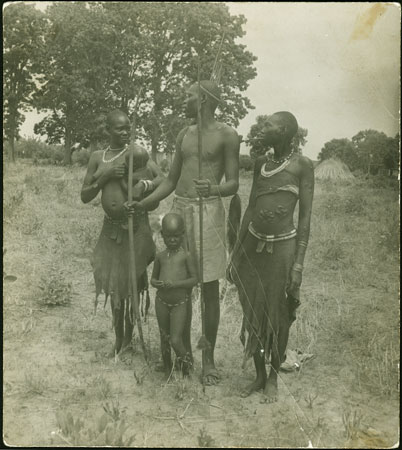Mandari family group

127 x 113 mm | Print gelatin silver
Condition:
diagonal crease marks [Chris Morton 3/11/2004]
Date of Print:
Unknown
Previous PRM Number:
JB.2.11
Accession Number:
1998.97.26.2
Description:
A standing group portrait of a hunter and two Mandari women, one with a breast-feeding baby and a young girl standing in front.
The woman to the right is smoking a pipe and wearing a metal disk fringed goat-skin apron with two bead waist strings, as well as a cloth breast covering and bead neck ornaments.
She also shows a number of scarification marks on her abdomen and arm, it being unclear whether these were intended to be decorative.
The young girl is wearing a single waist string of beads and a neck ornament, a common set of ornaments for young children.
The man has a goat-hair tassel attached to his arm and a goat-hair decorated quiver, bow and spear (for hunting), as well as some sort of hand weapon or ornament.
He is wearing European-style shorts and no display bead strings, possibly suggesting that he is married.
The women's skin skirts also suggest that they may be married, and that this may be a family group.
Photographer:
Jean Carlile Buxton
Date of Photo:
1950 - 1952
Region:
[Southern Sudan] Bahr el Jebel Tali
Group:
Mandari
PRM Source:
Ronald Carlile Buxton via Institute of Social and Cultural Anthropology
Acquired:
Donated 1988
Other Owners:
Jean Buxton Collection
Class:
Clothing , Weapon , Hunting , Ornament , Narcotic
Keyword:
Ornament Arm , Ornament Neck , Pipe , Bow , Arrow , Quiver
Documentation:
See Related Documents File. Buxton field notebooks in Tylor Library.
Primary Documentation:
Note on print reverse ms ink - "With best regards from Jean C Buxton (Ayak) Mandari 1950-1951" [
NB
Ayak was Buxton's Mandari name]
Other Information:
In Some Notes on the Mandari of Equatoria Province, A.E.
Sudan, (typescript notebook of c.1951 in Tylor Library, Institute of Social and Cultural Anthropology, University of Oxford), book IV, page 31-32 Jean Buxton notes that 'Young girls up till about the age of 3 or 4 run about naked or with a little waist band of beads round the hips.
After that they all wear some kind of covering round the parts.
In the past the traditional Mandari dress was a small leather apron with a fringe, or a chain apron with a fringe of metal links suspended round the edge.
This is now generally replaced by small pieces of brown cloth tied round the loins...and several strings are often wound round the waist above the cloth.
These treasures are usually presents from male admirers...When a woman is married, she always wears a skin - usually that of a goat from which the hairs have been removed, and which is treated with fat to make it soft and pliable and is then coloured a rich rust brown with red ochre - tied round her waist so that it hangs down behind.
Nowadays this skin is beginning to be replaced with pieces of cloth, which in an older woman is often tied across the breasts.' [Chris Morton 3/11/2004]
Recorder:
Christopher Morton 3/11/2004 [Southern Sudan Project]

